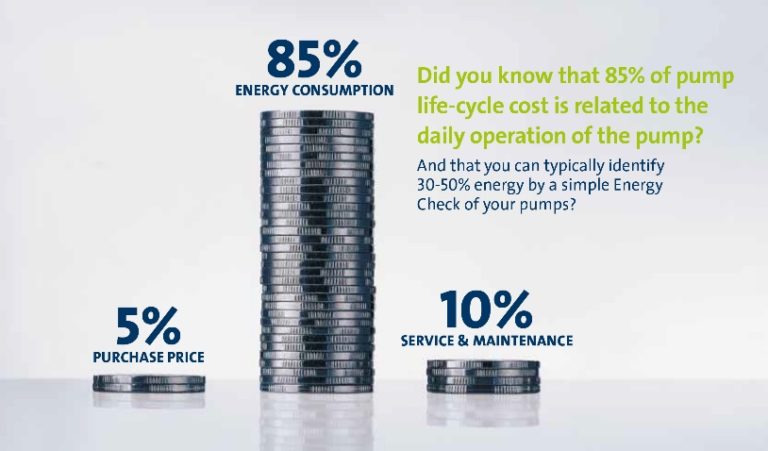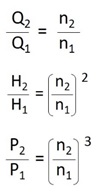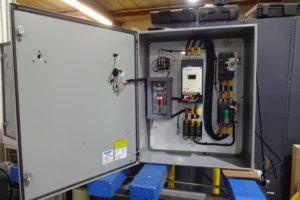Europump: Optimising Pump Systems to Save Electrical Energy

Image source: Europump
In this article, Steve Schofield, Europump Executive Council Member, and past Chair of the international working group responsible for ISO 14414 (Pump System Energy Assessment), offers some basic information and guidance on purchasing, maintaining and designing pump systems for optimum energy efficiency, maximum CO₂ reduction and best capital expenditure payback time.
Pump systems account for 20% of the worlds electrical energy demand and between 25% - 50% of the electrical energy usage in certain applications. Pumps are the single largest user of electricity within industry across the European Union, consuming over 300 TWhpa of electricity, which in turn accounts for over 65 Mton of CO₂ emissions.
It is also well documented that rotodynamic pumps which account for 80% of the installed base are between 20-30% oversized. There is therefore a major potential to save energy if rotodynamic pumps are properly sized and operated.
Where to start - Assess the potential for savings
Understand your pumping system:
To identify if a pumping system is sized correctly make the following checks;
- Are you wasting liquid flow?
- Are you creating additional pressure?
- What is the monitoring & controls philosophy?
- Are there any oversized pumps installed for your required duty?
- Are there any significantly old pumps employed in the system?
- Is there excessive noise in the system?
- Are there any throttling valves installed in the system?
- Have you the correct size of pipework installed?
- Inadequate maintenance lowers pump system efficiency, so what maintenance procedures are in place?
- Are you adopting a proactive equipment replacement programme to current EU legislation
Available Technology - Choosing the right equipment
Understanding Drive Technology:
Use latest EU regulation to achieve best possible drive efficiency;
- Variable speed drive (vsd)
- Integrated control and monitoring
- Permanent magnet technology
System Design - Making the right choices
The vast majority of existing pump systems operating today were not originally designed with energy conservation as a major consideration. If pump systems are initially designed on an energy efficient basis and pumps are correctly applied and sized the energy savings will often be in excess of 50%.
To design an energy efficient pump system all the following criteria should be considered:
- Basic plant layout
- Pipe size, configuration and restrictions to limited pipe work losses
- Information on the liquid, (viscosity, density, aggressiveness, temperature)
- System characteristics and pump selection
- Pump/System control
- Avoid oversizing of the pump units
- Selecting the most energy efficient pumps at the best efficient point
- Fitting VSD’s to match the system design & demand
Low energy costs are a direct result of knowing what is the minimum flow and pressure that the system requires to operate successfully (system demand) and then selecting the correct sized pump and matching it to the system.
When selecting a pump, it is important to determine the required flow and pressure to be generated by the pump. The flow may be determined by a process requirement, by the heating or cooling required in the system or by the peak water demand for utilities. The pressure required may be to elevate the liquid within the system or to overcome the pressure losses in the system created as liquid passes through it.
It is important to know as much about the pump system as possible and to create a pressure/flow profile for the system. The energy required to drive the pump is directly related to the flow and pressure required. To generate high pressures generally leads to designs which may be inefficient and therefore it is important that neither the flow nor the pressure is over specified.
Variable Speed Drives can save energy
It is now readily accepted that significant energy savings have already been made by using Variable Speed Drive and high efficiency motors. Generally, VSD’s are used to continually adjust the speed of the pump to the demand.
The savings can be determined by the affinity laws:

Q= Flow, H= Head, P = Power and n = Rotational Speed
When building a new pumping system, most pumps are selected with a "safety factor" in play to satisfy potential future uprates or to allow for wear in the pump or fouling of the system. Often there are many different parties involved in specifying and building a system and the safety factor can grow exponentially. This results in the pump delivering much higher flows than required. There may also be the need to vary the flow due to process conditions or varying heating and cooling needs within buildings.
Traditionally, throttling is used to regulate flow in a pumping system. While throttling reduces the flow, the motor is still running at full speed and works even harder as it has to work against a restriction. By reducing the speed of the motor, the variable speed drive ensures no more energy than necessary is used to achieve the required flow. A centrifugal pump running at half speed consumes only one-eighth of the energy compared to one running at full speed. Using an electrical Variable Speed Drive is the simplest and most economical way of controlling the pump and matching it to the pump system.
Here are some key considerations when looking to optimise the energy use in pumping systems:
Has an alternative configuration been considered?
In some cases, moving from an existing pump layout to an alternative can offer energy saving possibilities.
Is the Pump Performance Monitored?
By looking for early signs of pump wear which can include increased noise, vibration or power consumption, major energy and maintenance savings can be achieved.
Has ease of maintenance been allowed for?
When designing or replacing pumps, ease of future maintenance requirements should be considered.
Variable Speed Drive Considerations
When fitting VSD to a pumping system, output and input filters should be considered, along with insulated motor bearings.
Maintenance
When maintaining pumping systems, it is recommended to use original manufacturers’ recommendations and parts.
Reliability / Security
Efficient, well-maintained pumps are more likely to be reliable and unlikely to fail prematurely causing loss of production or services.
Valves
Valves are considered to waste energy within a pumping system, however if installed they should be checked for correct operation.
Pumps not in use
Stand by pump units or pumps with no demand should be switched off to save energy.
Is the pump working most of the time close to its best efficiency point?
Rotodynamic pumps operating away from BEP not only waste energy, but also reduce the life expectancy of the pump.
System Alterations
When upgrading, changing, or expanding a pumping system the demand may have changed and existing pumps may not be the most efficient solution.
Purchasing the correct pump set
When purchasing a pump set, price should not be the deciding factor. If a pump is sized correctly the return on investment is shorter, likewise if a pump is oversized and is wasting energy going forward you will have this additional cost for the anticipated life of the pump set.
Has an energy check been undertaken on existing systems?
The installed base of pumps is ten times the amount that are sold each year. Energy audits in accordance with ISO 14414 can identify substantial energy savings in existing pumping systems
When specifying a new pump, ask for a high efficiency motor to be fitted. If you are replacing or rewinding a motor, then evaluate the cost of fitting a high efficiency motor remembering to factor in the running savings which will pay back any increase in cost. Invest in conducting an energy audit. Review your utility bills and understand the energy you are using. Carry out an audit if:
- Your energy bills are high
- You have continuously operating pumps
- You have many pumps in the system
- You have processes with varying flows
- You have throttled pumps
- You have pumps which are on bypass
- You have noisy valves or pipework
- You have critical systems which have been subject to breakdowns
The purpose of an energy audit is to reduce operating costs by reducing energy consumption and the government has estimated that most companies can reduce their energy consumption by 10% to 20%. Energy audits carried out in accordance with ISO 14414 have shown that savings from 30 to 50% are not unusual. When deciding whether or not to carry out an energy audit a good starting point is to assume that you will save at least 10% of your current energy consumption. By reviewing utility bills, you can get an indication of the savings to be made and the investment that you should be prepared to put into the auditing process.
Across most industrial sites, some two-thirds of the total energy consumption is used to power electric motors. Furthermore, the overall cost associated with operating these essential pieces of equipment throughout their entire life span can be broken down as follows; 5% accounts for the initial purchase/installation costs, 10% for ongoing maintenance and a massive 85% for the energy used to run them. Clearly, any reduction in the energy consumed by electric motors is important, and with modern designs that reduction can be as much as 30%. It is also evident that many pumps and motors are constantly operated at full power, irrespective of process needs, and so across Europe’s installed base there is the potential for significant energy savings; savings which can in turn drop to the bottom line and increase the profitability of any business.
Source: Europump







